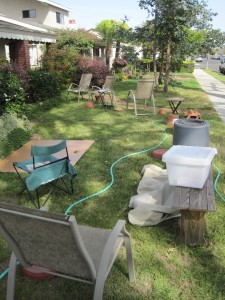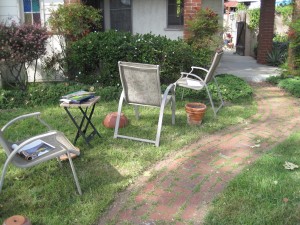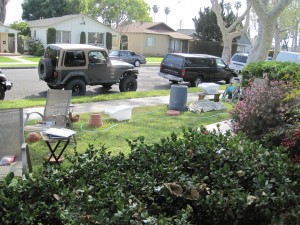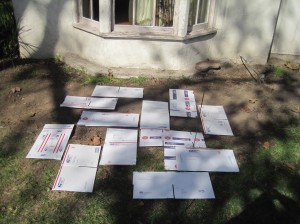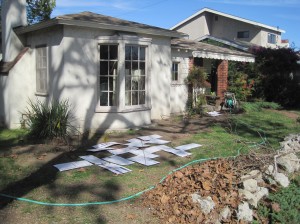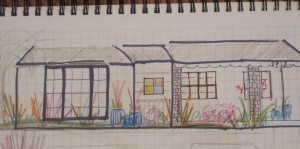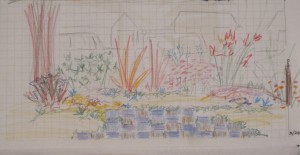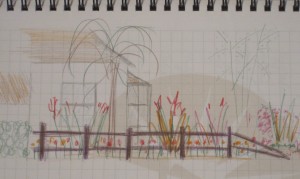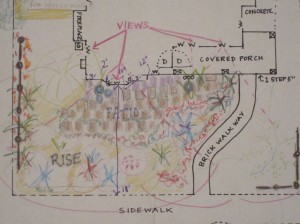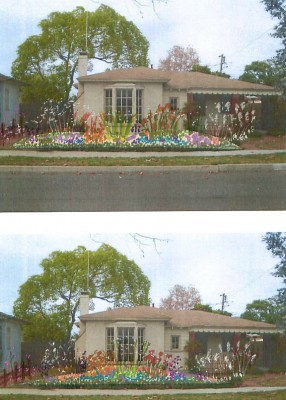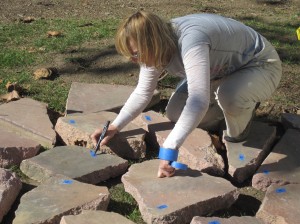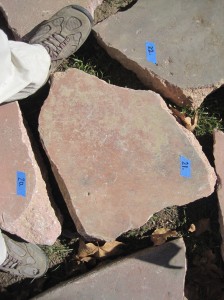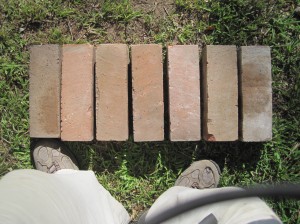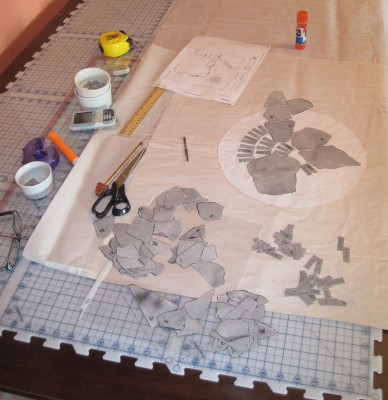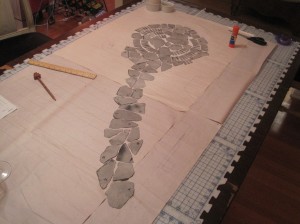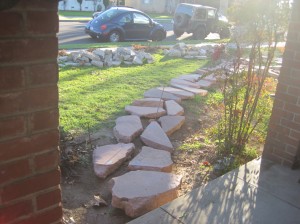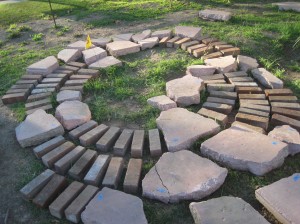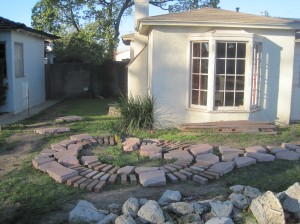What view did I wish to have? What view did I want to block? How would the space feel? Where would we sit and when we were sitting what would we see? Using chairs, containers, trash cans, tables, a rug and a garden hose I laid out a rough design on the front yard for the new garden and patio area. Tall chairs represented tall plants, the hose outlined the garden area while small pots and other containers represented smaller plantings. The bamboo floor mat gave me an idea of the patio space and its possible location in relation to the house and garden. With this set up (and a lot of imagination!) I could walk around and sit in the space to get a better sense of what it might actually feel like, something I couldn’t know just by looking at a design on paper.
Dave and I attended Planning Your ‘New California Garden’ a series of workshops at Madrona Marsh Nature Center. Through in class presentation and our personal work between classes we learned the practical steps to design a landscape plan for our gardens. The topics were:
- What are Your Assets? – Site/Self Assessment
- Water, Landscape and Hardscape
- Themes, Melodies & Garden Rooms – Design
- Choosing Your Plants with Confidence
- Student Presentations: Landscape Plans
Even with the information gained from these workshops I was a overwhelmed with knowing my next steps to really get the project moving. Selecting plants, pulling out old plants, deciding on a design for the hardscape and landscape, collecting materials, repairing the windows and repainting the woodwork, moving sprinklers, adding a drip system, adding electrical outlets…friend and Landscape Consultant Kathleen Brown helped me bring order to this chaos. Based on her input I developed a prioritized action plan with a timetable and a way to capture estimates and actual costs. Kathleen continues to be a sounding board and valuable resource especially as I get to plant selection.
Initially I intended to use 12″x12″ slate I had been given. Using cardboard pieces the size of the slate was easy to work with and play with different design layouts.
My concept sketches:
- Looking directly at the front of the house through a screen of tall plants near the sidewalk and potted plants against the house
- Looking from the living room window across the slate patio to the tall plants near the sidewalk and parked cars and houses across the street beyond
- Looking at our yard from our neighbor’s yard to the East; split rail fence and tall, breezy plants and trees
- Aerial view looking down on front yard
“One lump or two?” By working with a photo, construction paper and pens/pencils I could better visualize what the view of the front house could look like if we added either one or two mounds to the landscape, next to the sidewalk. The intention is to bring subtle elevation change to our otherwise flat yard.
For various reasons the slate was not going to work. Eventually I found the rosy-pink concrete which I felt certain would go beautifully with some brick I had found and already collected. Working out a plan with heavy, irregularly shaped concrete chunks presented a challenge. My solution was to work with photos of the concrete. I put a piece of tape with a number on each chunk of concrete and took a photo of each piece.
I downloaded the photos into my computer, printed out four images to a page, and cut out the image of each stone. Essentially these cutouts became a collection of numbered puzzle pieces and, because they were paper rather than the actual heavy concrete, they were very easy to work with. I had a large piece of paper with measurements of the front of the house, yard and other relevant features onto which I worked out the plan for the path and patio.
From my research I learned I wanted large stones in strategic locations. Larger stones and stones placed more closely together or in a different configuration than the stepping stones trigger the mind that this is a place for the body to stop. We have coloured glass windows near the porch, a nice spot for a person to stop. The patio section of the path would have much larger stones and be a much larger area. These would indicate stop, rest, enjoy the space. The configuration of other stones along the walking part of the path would trigger the mind that the body should travel from one point to the next.
I want traversing our front yard to be an enjoyable journey. Imagine enjoying the environment created by the plants, wildlife and stone every time we walk to and from the house. Since the garden will be along the sidewalk instead of against the house, passersby will also be able to enjoy the plants and wildlife up close.
Then I moved the actual pieces of concrete and brick into the position I had mapped out.
The result:Â I really like what I created!
The brick not only echoes the existing brick walkway and columns on the front porch but is also part of my story and the California story. The concentric brick circles remind me of a similar patio my parents designed and built when we lived together as a family in Boston. Their patio was made of old brick rescued from historic Cambridge and Boston streets that were being torn up and repaved. Instead of the brick being tossed into landfills my parents were able to use it in hardscape around their home. All these years later my reclaimed brick and design speak to that childhood memory, the historic East Coast and the familiar European influences in that part of the country.
The rosy pink coloured irregularly shaped concrete runs like a river from our porch across the front yard towards the West where it bursts through the concentric brick circles, pushing on further to the West. This represents the Westward movement of man (and me) from the traditional, historic East to the new, developing West. A quasi-Spanish style look is revealed in our 1939 home and coupled with the design concept of the pathway there is definitely a California story being told here.
Now I also had the plan on paper to use in conversation and further develop and implement my plan.
Dave and I are already enjoying afternoon cocktails on the “patio” because it’s always a good idea to test run these things…
